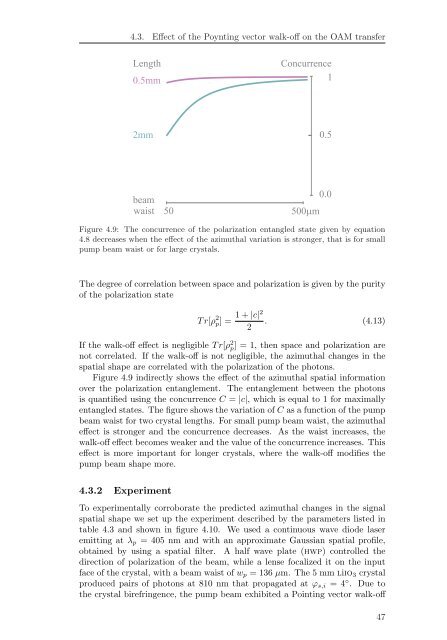Spatial Characterization Of Two-Photon States - GAP-Optique
Spatial Characterization Of Two-Photon States - GAP-Optique
Spatial Characterization Of Two-Photon States - GAP-Optique
You also want an ePaper? Increase the reach of your titles
YUMPU automatically turns print PDFs into web optimized ePapers that Google loves.
4.3. Effect of the Poynting vector walk-off on the OAM transfer<br />
Length<br />
0.5mm<br />
2mm<br />
beam<br />
waist<br />
Concurrence<br />
1<br />
50 500m Figure 4.9: The concurrence of the polarization entangled state given by equation<br />
4.8 decreases when the effect of the azimuthal variation is stronger, that is for small<br />
pump beam waist or for large crystals.<br />
The degree of correlation between space and polarization is given by the purity<br />
of the polarization state<br />
T r[ρ 2 p] =<br />
0.5<br />
0.0<br />
1 + |c|2<br />
. (4.13)<br />
2<br />
If the walk-off effect is negligible T r[ρ 2 p] = 1, then space and polarization are<br />
not correlated. If the walk-off is not negligible, the azimuthal changes in the<br />
spatial shape are correlated with the polarization of the photons.<br />
Figure 4.9 indirectly shows the effect of the azimuthal spatial information<br />
over the polarization entanglement. The entanglement between the photons<br />
is quantified using the concurrence C = |c|, which is equal to 1 for maximally<br />
entangled states. The figure shows the variation of C as a function of the pump<br />
beam waist for two crystal lengths. For small pump beam waist, the azimuthal<br />
effect is stronger and the concurrence decreases. As the waist increases, the<br />
walk-off effect becomes weaker and the value of the concurrence increases. This<br />
effect is more important for longer crystals, where the walk-off modifies the<br />
pump beam shape more.<br />
4.3.2 Experiment<br />
To experimentally corroborate the predicted azimuthal changes in the signal<br />
spatial shape we set up the experiment described by the parameters listed in<br />
table 4.3 and shown in figure 4.10. We used a continuous wave diode laser<br />
emitting at λp = 405 nm and with an approximate Gaussian spatial profile,<br />
obtained by using a spatial filter. A half wave plate (hwp) controlled the<br />
direction of polarization of the beam, while a lense focalized it on the input<br />
face of the crystal, with a beam waist of wp = 136 µm. The 5 mm liio3 crystal<br />
produced pairs of photons at 810 nm that propagated at ϕs,i = 4 ◦ . Due to<br />
the crystal birefringence, the pump beam exhibited a Pointing vector walk-off<br />
47



